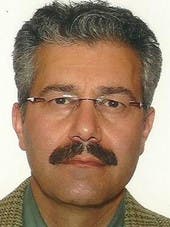Taking stock of Iran’s crimes against humanity 30 years after 1988 massacre
On July 26, Amnesty International
renewed its warning of many years that the
theocratic regime in Iran is
destroying all the evidence of 1988 massacre of political prisoners. Since the
massacre the only visible proof of it are mass graves where bodies
of the
prisoners were piled up.
There is also a constant reminder for
the rest of us that such heinous crime has not been thoroughly investigated by
an independent international commission.
Amnesty International in its Urgent
Action said: “ROAD TO BE BUILT OVER INDIVIDUAL AND MASS GRAVES. The families ofpolitical dissidents who were forcibly disappeared and extra-judicially killedin Ahvaz, southern Iran, in the 1980s are suffering untold mental anguish and
distress as the authorities are destroying the individual and mass graves of
their loved ones. They are afraid of facing further persecution if they speak
out.”
In the previous month, the mass
graves of the martyrs of the 1988 massacre and other PMOI martyrs in
Behesht-e-Reza Cemetery in Mashhad, capital of Razavi Khorasan Province
(northeastern Iran), had been destroyed on the orders of the clerical regime’s
officials.”
Who were the prisoners and what
happened
According to sources close to Iran’s
main opposition, in the summer of 1988 political
prisoners serving their
sentences were mass executed. The order, according to them, came from the very
top. It was written in a notorious fatwa (religious edict) that all those who still
believe in People’s Mojahiden Organization of Iran (PMOI/MEK) must be killed.
In one summer around 30,000 political
prisoners were executed and buried in mass graves in Iran. Khomeini and his
cohorts knew that if the crime goes public it will be a major disaster. The
so-called judges were strictly ordered to hide everything. Years later, it was
revealed that all prisoners in that period were denied visitation rights for
months.
Since the early days after 1988, The
NCRI and MEK were tasked to expose the crime worldwide. Not a single
international body was left out in this endeavor for past three decades.
A month later, an audio tape was
leaked out by Ayatollah Hossein-Ali Montazeri’s son in August 2016. Montazeri,
the handpicked successor of Khomeini, was sacked for his public objections to
mass executions in 1988. He spent the rest of his life under house arrest and
died in 2009.
In the tape, Montazeri is purportedly
heard telling a meeting of the “Death Commission” in 1988 that they are
responsible for the crime against humanity.
He said: “The greatest crime
committed during the reign of the Islamic Republic, for which history will
condemn us, has been committed by you. Your names will in the future be etched
in the annals of history as criminals.” Pour-Mohammadi has since admitted his
role in the “Death Commission” and boasted that he was proud to “carry out
God’s will and he has not lost sleep over what he did.”
A four-member committee – famous
among prisoners as Death Commission – consisted of the most ruthless killers in
the regime tasked to carry out the executions. Some of them are still around
and hold high offices including Pour-Mohammadi, Justice Minister in Hassan
Rouhani’s first cabinet and now an advisor to regime’s head of judiciary.
Ebrahim Raisi was a low-level cleric
at the time was another known member of the commission. In return for his
services Raisi rose in the rank and files of the regime’s hierarchy. He is a
close confidant of the Supreme Leader Ali Khamenei.
Currently Raisi is the custodian of
Astan Quds Razavi, the wealthiest charity foundation in charge of Iran’s
holiest shrine in Mashhad, northeastern Iran, with close ties to Khamenei’s
powerhouse. He ran for presidential office last year and lost to Rouhani.
Alireza Avaie Succeeded
Pour-Mohammadi. He was appointed Justice Minister in Hassan Rouhai’s second
cabinet. Avaie is as guilty as his predecessor.
Avaie’s personal record in
participating in human rights violations goes a long way back when he was
partner in crime with the likes of Raisi. He was also a member of Death
Commission in southwestern Iran.
Gradual international recognition
Canada’s Parliament adopted the
following motion on June 5, 2013: “That the House condemn the mass murder of
political prisoners in Iran in the summer of 1988 as a crime against humanity,
honor the memory of the victims buried in mass graves at Khavaran cemetery and
other locations in Iran, and establish September 1 as a day of solidarity with
political prisoners in Iran.”
On April 26, the US House of
Representatives passed H.R.4744 Act, holding the Iranian regime accountable for
its brutality, with an overwhelming majority of 410-2.
The bipartisan legislation holds
Iranian regime officials accountable for their role in human rights abuses and
hostage-taking, and requires imposition of sanctions against them. The bill
also condemns and calls for investigations into the 1988 mass executions of
30,000 political prisoners.
For three decades, the theocratic
regime in Tehran tried to pull the wool on the world’s eyes and hid his most
heinous crime since Second World War.
Had this crime against humanity
received deserved international attention, the Iranian regime would have been
stopped a long time ago. No doubt the regime’s Achilles’ heel is human rights.
__Source:








Comments
Post a Comment